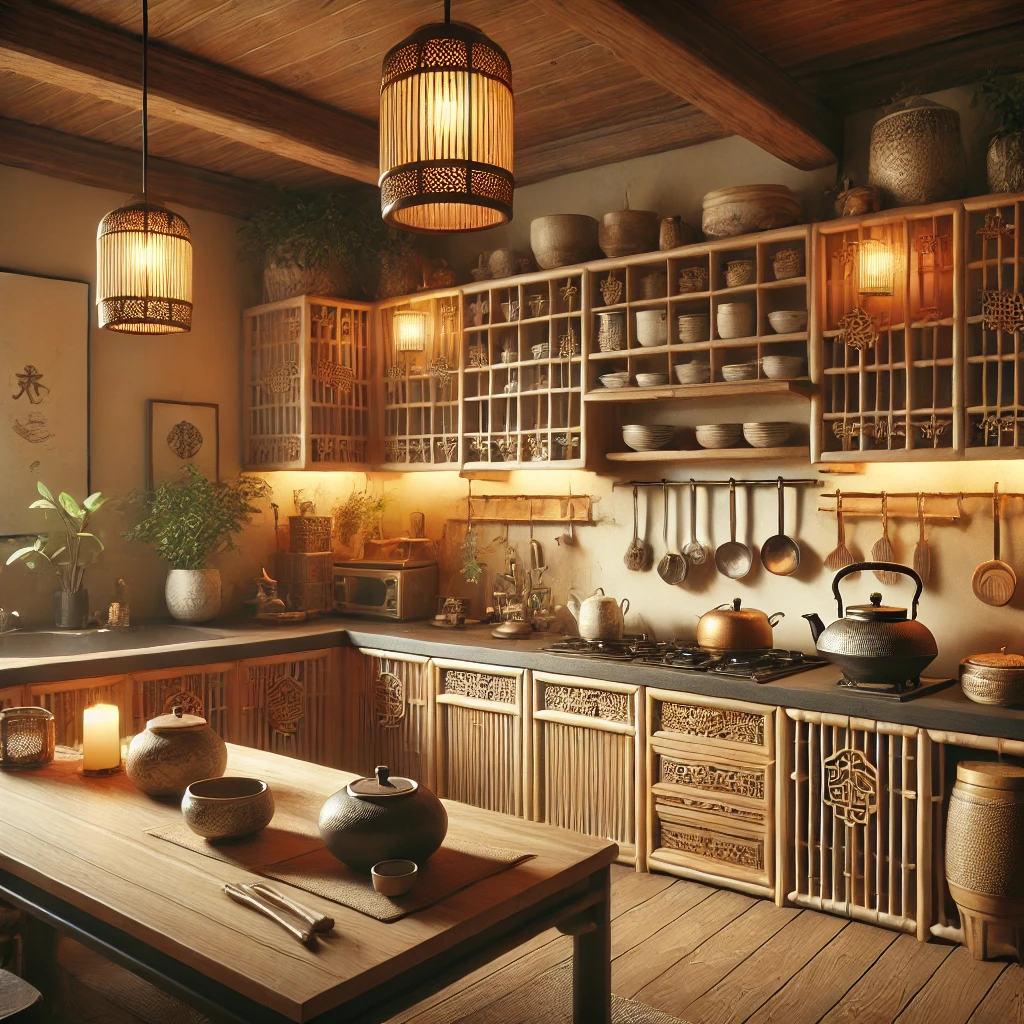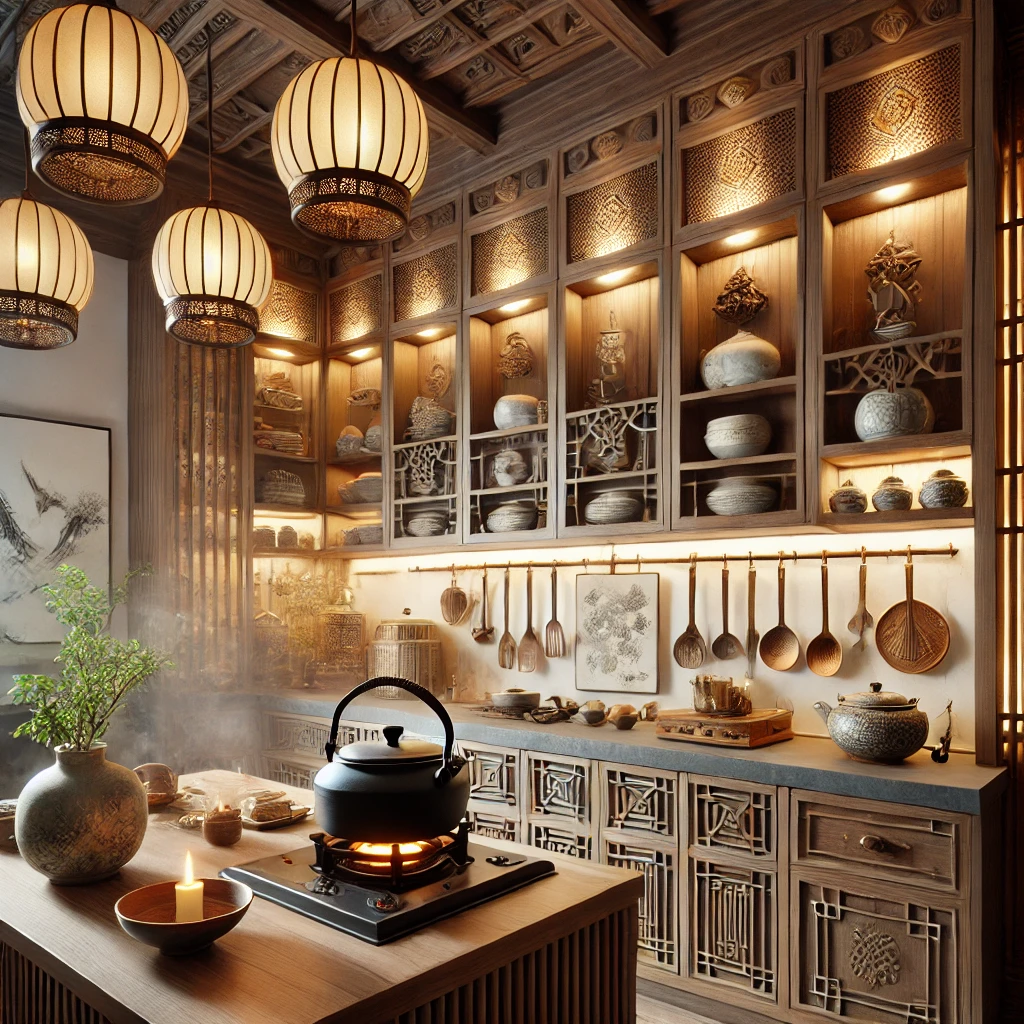Mastering the Art of the Oriental Kitchen
What Makes an Oriental Kitchen Unique?
An Oriental kitchen is much more than just a place for cooking—it’s a fusion of history, culture, and culinary artistry. The term “Oriental kitchen” encompasses kitchens from diverse Asian cultures, including Chinese, Japanese, Korean, Vietnamese, and Thai. These kitchens are defined by their use of fresh ingredients, aromatic spices, and time-honored cooking techniques that emphasize balance and flavor harmony. From the arrangement of utensils to the choice of ingredients, every aspect of an Oriental kitchen is designed to create an immersive cooking experience. It’s not only about the food but also the philosophy of balance and respect for nature.
Traditional Tools Found in an Oriental Kitchen
In an Oriental kitchen, the choice of tools is crucial for achieving authentic flavors. The wok, with its curved design, is a staple, allowing for stir-frying, deep-frying, steaming, and more. Bamboo steamers, mortar and pestles, and clay pots also play significant roles in cooking. Chopsticks, not just for eating, are often used for cooking, making them versatile tools in an Oriental kitchen. These traditional tools reflect the resourcefulness and ingenuity that characterize Asian culinary traditions. By using the right tools, the cooking process becomes a blend of precision and creativity, essential to preparing dishes that stay true to their roots.
Essential Ingredients for an Oriental Kitchen
No Oriental kitchen is complete without a selection of essential ingredients that define its distinctive flavors. Soy sauce, fish sauce, rice vinegar, and sesame oil are among the most common condiments, providing a deep umami taste that enhances dishes. Fresh ingredients like ginger, garlic, scallions, and chili peppers add complexity to the meals. Herbs like Thai basil, cilantro, and lemongrass are often used to elevate dishes with fresh, aromatic notes. Rice, noodles, and tofu serve as fundamental building blocks in many recipes, while dried ingredients like shiitake mushrooms and seaweed add depth and earthiness. Each ingredient in an Oriental kitchen is chosen for its unique ability to balance flavors.
The Role of Spices in an Oriental Kitchen
Spices are the heart and soul of an Oriental kitchen, creating a symphony of flavors that range from spicy and sweet to tangy and savory. Star anise, Sichuan peppercorns, cinnamon, cloves, and fennel seeds are key spices in Chinese five-spice powder, a popular seasoning that adds warmth to meats and stews. In a Japanese Oriental kitchen, wasabi and ginger provide a punchy contrast to the umami-rich flavors of soy sauce and miso. Thai cuisine, on the other hand, relies on chili, lemongrass, and galangal to create its signature spice blends. These spices not only season dishes but also have medicinal properties, reflecting the holistic approach of Oriental cuisine.
How to Design an Authentic Oriental Kitchen
Creating an authentic Oriental kitchen at home involves more than just the right ingredients and tools—it’s about designing a space that embodies simplicity and functionality. Opt for a layout that allows for easy movement between the stove, sink, and preparation area. Incorporate natural materials like wood, bamboo, and stone, which are common in Asian design, to give the space a warm, earthy feel. Open shelving is a popular choice in an Oriental kitchen, allowing easy access to spices and utensils. Adding traditional elements like paper lanterns, rice paper screens, and calligraphy art can bring a touch of elegance and authenticity to the space, transforming your kitchen into a serene haven.

The Philosophy Behind an Oriental Kitchen
The Oriental kitchen is deeply rooted in the philosophy of harmony and balance, reflecting broader principles in Eastern cultures. The concept of “yin-yang” plays a central role, emphasizing the balance between hot and cold, light and dark, and sweet and savory in both cooking and life. Dishes in an Oriental kitchen aim to achieve this balance, using ingredients and flavors that complement each other perfectly. This approach extends beyond food to the kitchen environment itself, which is designed to be clean, organized, and harmonious. This philosophy fosters a space that is conducive to creativity and mindfulness in cooking.
The Importance of Freshness in an Oriental Kitchen
Freshness is paramount in an Oriental kitchen, where the quality of ingredients can make or break a dish. Vegetables, herbs, and seafood are often sourced from local markets, ensuring that they are used at their peak flavor. The emphasis on fresh ingredients aligns with the cultural practices of eating seasonally, which is a cornerstone of Oriental cuisine. Fresh produce like bok choy, bean sprouts, and Asian greens are often used within a day or two of purchase. This focus on freshness not only enhances the flavor but also ensures that dishes are rich in nutrients, contributing to a balanced and healthy diet.
Popular Dishes in an Oriental Kitchen
The Oriental kitchen is known for its variety of popular dishes that are enjoyed around the world. Chinese dumplings, Japanese sushi, Thai curries, and Vietnamese pho have all become global favorites. These dishes are not only delicious but also showcase the diversity and depth of flavors found in an Oriental kitchen. Each dish has its own unique story, influenced by regional ingredients and cooking techniques. For example, Chinese dim sum is a symbol of communal dining, while sushi represents the Japanese art of precision. These dishes highlight the creativity and craftsmanship that make Oriental cuisine so distinctive.
Cooking Techniques in an Oriental Kitchen
The cooking techniques used in an Oriental kitchen are as varied as the ingredients themselves. Stir-frying is a quick and efficient method that locks in flavor while preserving the texture of vegetables and proteins. Steaming is another popular technique, especially in Chinese and Japanese cooking, as it allows ingredients to retain their natural flavors without the need for added fats. Braising, deep-frying, and grilling are also common, each contributing a unique texture and depth to dishes. Mastering these techniques is key to creating the complex and nuanced flavors that define an Oriental kitchen, allowing cooks to bring a taste of Asia into their own homes.
The Art of Presentation in an Oriental Kitchen
In an Oriental kitchen, presentation is considered as important as taste. The visual appeal of a dish is thought to enhance the dining experience, making meals not only delicious but also beautiful. Japanese cuisine, for instance, places a strong emphasis on the aesthetic arrangement of food, often using bento boxes and lacquered trays. In Chinese cooking, colorful vegetables and carefully cut ingredients create a vibrant and inviting look. Even garnishes like cilantro, sliced chilies, and scallions are thoughtfully arranged. This attention to presentation reflects the respect for food and the desire to create a dining experience that engages all the senses.
Creating an Oriental Kitchen Pantry
Stocking your pantry with essential items is key to maintaining an efficient Oriental kitchen. A well-stocked pantry should include a variety of sauces like soy sauce, oyster sauce, hoisin, and miso paste, as well as dried goods such as rice, noodles, and dried seaweed. Spices like star anise, Sichuan pepper, and dried chili are crucial for adding depth to dishes. Additionally, keeping a selection of pickled vegetables and fermented ingredients like kimchi and miso can add layers of flavor to your cooking. With these ingredients on hand, you can create a wide range of dishes that capture the essence of the Oriental kitchen.
Health Benefits of Cooking in an Oriental Kitchen
Cooking in an Oriental kitchen often means using fresh ingredients and balanced recipes that are rich in nutrients. Traditional dishes like miso soup, stir-fried vegetables, and herbal teas are known for their health benefits, including digestive support and boosting the immune system. Many Oriental dishes are low in unhealthy fats and sugar, making them suitable for a variety of dietary needs. Ingredients like ginger, garlic, and turmeric, common in many Asian dishes, are also known for their anti-inflammatory properties. The holistic approach to cooking in an Oriental kitchen promotes overall well-being, making it a great choice for those looking to maintain a balanced diet.
Integrating Modern Trends in an Oriental Kitchen
While tradition remains important, modern trends have found their way into the Oriental kitchen, blending old and new in exciting ways. Many contemporary Oriental kitchens now incorporate advanced appliances like induction cooktops, air fryers, and multi-cookers, allowing home cooks to experiment with both traditional and modern techniques. Fusion cuisine, which combines elements of Western and Eastern cooking, has also gained popularity. This trend has led to the creation of new dishes like sushi burritos and Asian-inspired tacos, bringing a fresh twist to classic flavors. Integrating modern trends into an Oriental kitchen keeps it dynamic and adaptable to the evolving culinary landscape.
Tips for Beginners in an Oriental Kitchen
Starting out in an Oriental kitchen can seem daunting due to the range of ingredients and cooking methods, but a few key tips can make the process smoother. Begin with simple recipes like stir-fried noodles or fried rice, which use basic techniques and familiar ingredients. Invest in quality tools, like a good wok and sharp knives, to make cooking more efficient. Don’t be afraid to experiment with different sauces and spices to develop your palate. As you become more comfortable, try tackling more complex dishes like ramen or Peking duck. The journey of mastering an Oriental kitchen is as rewarding as the dishes you’ll create along the way.
Finding Balance in an Oriental Kitchen
Balance is the cornerstone of cooking in an Oriental kitchen. This balance is not only about flavors but also extends to textures, colors, and even the atmosphere of the kitchen itself. A successful dish balances salty, sweet, sour, bitter, and umami flavors, creating a harmonious taste profile. Similarly, dishes often combine crunchy, chewy, and soft textures, making each bite a delight. The balance in an Oriental kitchen creates a space where the culinary process is as enjoyable as the final meal, fostering a love for cooking that is deeply satisfying.
The Cultural Significance of an Oriental Kitchen
The Oriental kitchen is more than just a place to prepare food; it is a reflection of culture, tradition, and family. In many Asian cultures, the kitchen is considered the heart of the home, where families come together to cook and share meals. Traditional dishes are often prepared during festivals and celebrations, carrying with them centuries of history and meaning. For example, making dumplings during Chinese New Year symbolizes prosperity, while the preparation of sushi in Japan represents a celebration of nature’s bounty. The cultural significance of an Oriental kitchen is what makes it so rich and inviting, preserving the heritage of diverse Asian cuisines.




